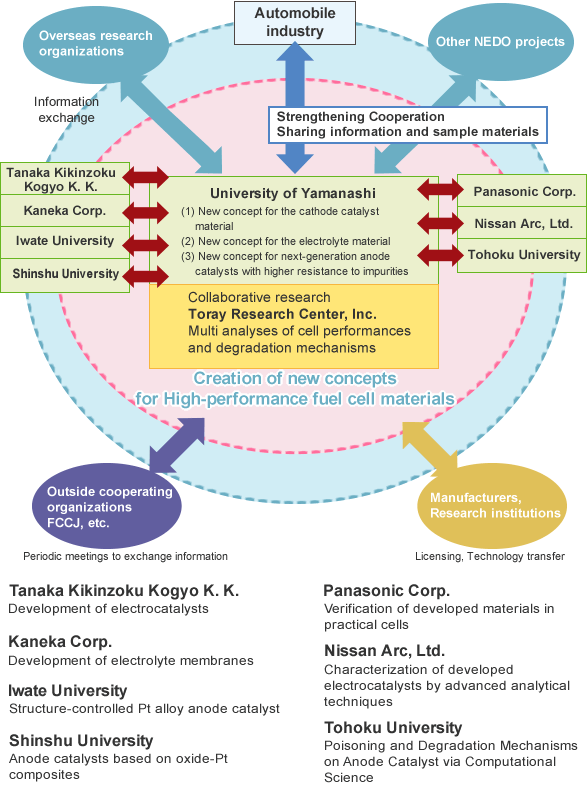Superlative, Stable, and Scalable Performance Fuel Cell Project
Project Objectives
The Center has been investigating new catalysts and membranes for polymer electrolyte fuel cells with high performance, reliability and low cost under the “HiPer-FC (High Performance Fuel Cell)” project funded by NEDO, Japan (starting in April, 2008). The project was rewarded with the development of superior materials and a number of new scientific insights, as shown below: Stabilized Pt-skin alloy catalysts; conducting ceramic supports with fused-aggregated network structure, with excellent stability during potential variation; and hydrocarbon electrolyte membranes, with similar proton conductivity and higher durability compared with the fluorocarbon electrolyte membranes.
The present “S-Per-FC” (Superlative, Stable, and Scalable Performance Fuel Cell) project started in May, 2015 with funding from NEDO, Japan, in which our Center is the core of the project organization. The main purpose of the project is to contribute strongly to the large-scale proliferation of fuel cells vehicles based on these superior outcomes. Membrane-electrode assemblies, in which both catalysts and membranes have shown limited performance, will be developed on the basis of scientific insights, and the performance will be elucidated by the use of state-of-the-art analytical systems. The new concept of high power, high durability and high efficiency materials will be pursued. Using this new concept, we will contribute to the development of low cost fuel cell vehicles, including commercial vehicles, using low amounts of precious metals and with higher durability.
Research Items
- 1. Creation of a new concept for the cathode catalyst material
- Create a new concept for the dramatic improvement of activity and durability of the cathode catalyst via analysis of Pt-skin alloy catalysts, carbon supports, conductive ceramics, as well as the detailed structure of their interfaces and surface electronic states. The effects of the new concepts will be verified via measurements on the carbon-support-based and ceramic-support-based cathode catalysts and MEAs using those catalysts.
- 2. Creation of a new concept for the electrolyte material
- Create a new concept for a highly durable, highly conductive electrolyte material, even under the fuel cell operating conditions of a wide range of temperature and humidity, via the evaluation and analysis of the molecular structure, the higher order structure, and morphology of the hydrocarbon-based electrolyte membrane and binder, taking into account the behavior of water molecules.
- 3. Creation of a new concept for next-generation anode catalysts with higher resistance to impurities
- Establish design guidelines for anode catalysts that can enable low-platinum usage, high robustness and high durability, via evaluation of MEAs using these catalysts.
Targets of the project
In order to put the materials developed using these concepts into practical use by the next stage of proliferation of fuel cell vehicles starting in FY 2025, we will establish the fundamental technology by FY 2019, realizing a 10-fold increase in the cost performance based on the quantity (power density × lifetime) / (mass of precious metals) compared to that of the conventional fuel cell.
Organization of the Research and Development
As the Project Leader, the University of Yamanashi is carrying out the research and development in cooperation with Tanaka Kikinzoku Kogyo K. K., Kaneka Corp., Panasonic Corp., Nissan Arc, Ltd., Toray Research Center, Inc., Iwate University, Shinshu University and Tohoku University.


